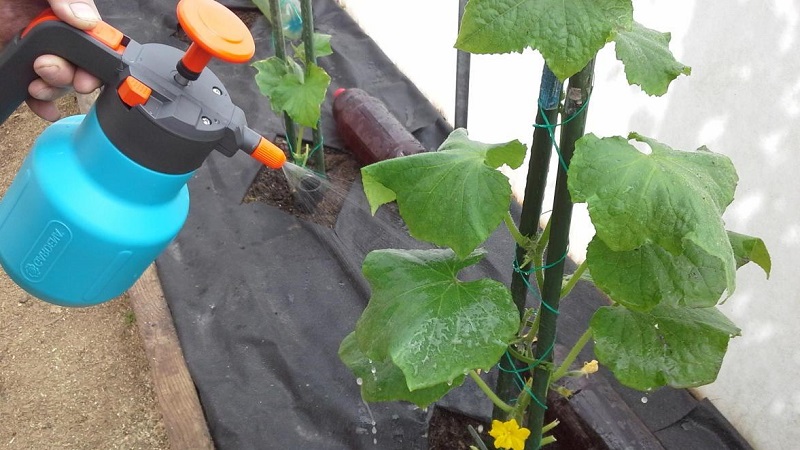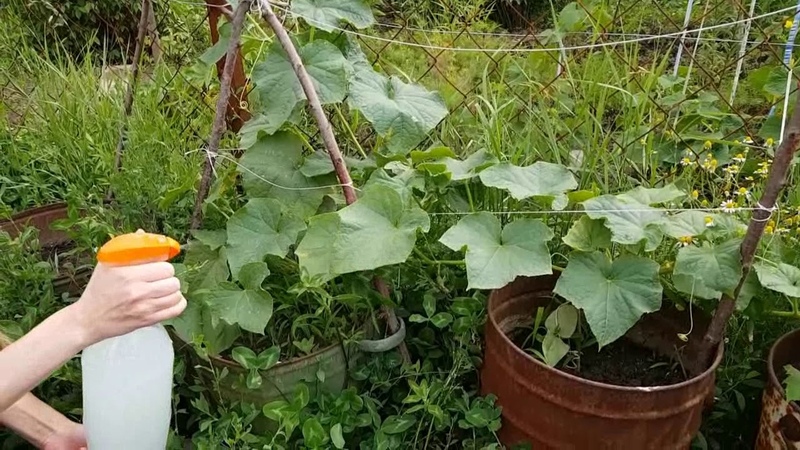What is useful for feeding cucumbers with ammonia and how to use it correctly
Even ordinary vegetables such as cucumbers take a lot of effort to get a good harvest. Often all efforts go to waste due to infections, pests or soil imbalances. In such cases, there is always a choice: expensive special drugs and inexpensive folk remedies.
Feeding cucumbers with ammonia is a common practice since the days of the Soviet Union. How useful such a fertilizer is, how to properly prepare the solution and what nuances should be considered when working with ammonia - you will learn all this from our article.
The content of the article
Why feed cucumbers with ammonia
Ammonia has long been used not only in medicine. Experienced housewives use this inexpensive tool to take care of the cleanliness of glasses, dishes, jewelry and clothes. Over time, ammonia began to be used in the garden. It is used in the fight against insects, in the treatment of diseases, as well as for plant fertilization.
What does he give

Nitrogen is an element necessary for the full development of plants. Cucumbers most often suffer from a lack of it. Ammonia is 41% nitrogen.
Benefits of ammonia:
- does not oversaturate plants with nitrogen;
- does not contribute to the accumulation of nitrates in fruits;
- more efficient than industrial fertilizers;
- does not acidify the soil;
- does not harm pollinating insects;
- low cost.
Disadvantages of the product:
- high volatility;
- the need to comply with precautions;
- sharp unpleasant odor.
Fertilizer properties
Ammonia is an aqueous solution of ammonia. It is a colorless liquid with a very pungent odor. In medicine, a 10% solution of the drug is used; in the garden, various concentrations of ammonia are used.
Treatment of cucumbers with a solution of ammonia strengthens young seedlings. This is especially important during the period of planting in a permanent place, when young shoots are stressed from changes in environmental conditions. Also, ammonia increases the number of ovaries, protects against insect pests and diseases.
Important! Ammonium is suitable for fertilizing cucumbers, tomatoes, bell peppers, onions, garlic, berries, and bulbous flowers.
How to prepare a solution
In its pure form, ammonia is not used because of its toxicity. It is not difficult to prepare a solution for feeding cucumbers. It is important not to exceed the dosage in order not to harm the plants. In order not to doubt the correctness of the proportions, ammonia is measured not by eye, but using a medical syringe or dispenser.

Correct proportions
Ammonia for cucumbers is used in different concentrations, the dosage depends on the degree of nitrogen starvation and the phase of plant development.
The universal proportion is 50 ml of ammonia per 4 liters of water. For foliar treatments, use a weaker solution - 1 tbsp. l. preparation for 10 liters of water. Concentrate - 1 dessert spoon of ammonia per 1 liter of water.
Experienced gardeners also use the following dosages:
- for root feeding - 3 tbsp. l. preparation for 10 liters of water;
- for foliar - 50 ml of 10% ammonia per 10 liters of water.
How and when to fertilize correctly
The processing of cucumbers with ammonia should not be haphazard. When the soil is oversaturated with nitrogen, the plant begins to "fatten" - the vegetative growth is activated, the yield decreases. It also increases the risk of developing fungal infections.
Ammonium is used for:
- root feeding;
- foliar processing;
- rubbing leaves.
Instructions for processing cucumbers with ammonia are given in the table.
| Processing method | Development phase | Amount of 10% solution of ammonia per 10 liters of water |
| Spraying | The appearance of two true leaves | 20 ml |
| 10-15 days after planting seedlings | ||
| Flowering period | ||
| Watering | Seedling | 50 ml |
| Bloom | 90 ml | |
| Ovary formation | 45 ml | |
| Nitrogen deficiency | 120 ml | |
| Disease prevention | 50 ml |
Ammonia treatment is carried out after sunset in calm weather or in the morning of a cloudy day. After each feeding, it is necessary to monitor the reaction of the plant to the treatment.
Feeding frequency
Fertilizers with ammonia are used both outdoors and in greenhouses and hotbeds. Cucumbers are fertilized in different phases of growth, but most of all the plant needs feeding during transplantation to the garden.

Experienced gardeners use the following ammonia feeding scheme:
- The first root treatment is carried out with the appearance of true 4-5 leaves. The beginning of active growth of cucumbers falls in early summer and late spring.
- Subsequent dressings are applied weekly in the phase of active green mass growth. Use a universal solution.
- During the period of active formation of ovaries, treatment is carried out twice a week with a concentrated solution.
- As soon as the stems and leaves have become strong and bright green, the universal dressing is applied once a week.
- The number of procedures is reduced before flowering and fruiting. For feeding, use a weak solution of ammonia and manure.
Ammonia can be combined with other dressings. In case of slowing down the growth of cucumber lashes, a large number of barren flowers and the absence of ovaries, phosphorus fertilizers are added.
Important! When a large number of barren flowers are formed, cucumbers are watered with ammonia twice a week.
Feeding methods
Ammonia is used for root and foliar processing. The drug can fertilize the substrate, as well as feed the plants.
Under the root
The solution is used to replenish the deficiency of nitrogen involved in metabolic processes. Cucumbers especially need feeding during the active growth phase.
Signs of a nitrogen deficiency:
- yellowing of the leaves;
- the formation of small leaves throughout the plant;
- thinning and fragility of the stem;
- violation of growth and flowering;
- plant sensitivity to frost.
The first time the cucumbers are fertilized with ammonia after the appearance of real 4-5 leaves. During this period, the plant begins to branch. The solution is applied at the root, the frequency of watering depends on the state of the seedlings.
Young seedlings are treated with ammonia, as well as plants grown by the non-seedling method. Cucumbers are poured with a solution from a watering can without a spray, with a weak stream. Consumption: 1 liter of solution per bush.
Important! To protect the leaves from burns, they are sprayed with clean running water.
Foliar
The goal of foliar treatment is to quickly eliminate nitrogen starvation. The procedure is carried out using a watering can by watering. A spray bottle is ineffective in spraying ammonia. The working solution is unstable, most of it evaporates during spraying.
Some vegetable growers, with a pronounced nitrogen deficiency, use ammonia for spraying - this way the leaves get the necessary element faster. Use a spray gun in the "spray" mode, but it should be borne in mind that most of the ammonia will remain in the air.
The leaves are also rubbed with ammonia to protect them from pests. During the procedure, make sure that the solution evenly covers the entire green mass.
Application against pests and diseases
Ammonia is a powerful agent; it is used on the site and in the fight against pests and diseases. The pungent odor repels insects, while the active compounds protect against infections.

From pests
Ammonium is used to eliminate spider mite, aphids, whitefly, wireworm and bear. If you do not get rid of insects during the time, you can lose the entire crop.
To treat cucumbers from aphids, the foliage is wiped with this solution: 50 ml of 10% ammonia, 10 liters of water and 100-200 g of crushed laundry soap. The soap helps the solution adhere to the green mass and prevents volatilization.
Vegetable growers note that to get rid of pests, it is enough to treat with such a solution once. If, after the procedure, the aphid continues to infect the cucumbers, you can repeat the treatment after two weeks.
Against the wireworm and the bear, a less concentrated solution is used: 1 tbsp. l. preparation for 10 liters of water. The treatment is carried out by spraying.
The following solution helps from whitefly and spider mites: 10 ml of ammonia, 10 liters of water and 1 tbsp. l. liquid soap. The product is used to spray the seedlings and wipe the affected areas of the plants.
For prevention
Ammonia solution protects against bacterial and viral infections. Dilute it in a proportion of 10 ml of ammonia per 10 liters of water. The soil is watered with a liquid before sowing seeds, as well as holes when planting seedlings.
Treatment instructions for diseases:
- Affected leaves and stems are removed.
- A solution is prepared from 50 ml of ammonia and 10 liters of water.
- The liquid is applied to the stem and leaves with a spray gun in the "spray" mode.
- The remaining solution is poured over the bush under the root.
- The procedure is repeated after 10-15 days.
At the first symptoms of fungal diseases, the concentration of ammonia in the solution is reduced or switched to other fertilizers.
Precautions for use
Pure ammonia is harmful to humans. Aqueous solution in contact with skin and mucous membranes causes burns. Therefore, when working with ammonia, you should follow the safety rules:
- use protective equipment: rubber gloves, goggles and a respirator;
- when processing plants, keep to the windward side so that the solution does not get on the skin;
- when working in the greenhouse, it is necessary to open the frames and the door;
- rinse the place of contact with the body with plenty of water.
Ammonia vapors can be on the surface of the fruit, therefore, the cucumbers are thoroughly washed under running water before use.
Important! At the first sign of poisoning, you should drink a glass of milk and see a doctor.
Reviews
The use of ammonia in the garden is the subject of many years of controversy. Despite the benefits and effectiveness of the remedy, many do not use it because of the great danger to humans.
Vladimir, Novokubansk: «For feeding cucumbers in a greenhouse, I use a universal and weakly concentrated solution of ammonia. To protect the leaves from burns, water is sprayed on them from a spray bottle in the "fog" mode. The plants are healthy, protected from pests, and the harvest is always pleasing. "
Irina, Moscow region: “For several years I have been processing my cucumbers with ammonia. In the new season I decided to try new fertilizers. As a result - an invasion of pests, yellowing of foliage and dropping of ovaries. I had to go back to a proven tool. I heard that insects can develop resistance to the drug, but so far I haven’t found an alternative to ammonia ”.
Ivan, Minsk: “I am against ammonia - it is toxic to humans and evaporates easily. I give preference to preparations containing nitrogen - "Carbamide", ammonium nitrate and ammonium sulfate.
Read also:
How often to water eggplants: instructions for beginner gardeners.
Dill grows poorly - how to feed for a good harvest and how to do it right.
The favorite of many summer residents is the White Angel cucumber variety.
Conclusion
Ammonia is an inexpensive pharmaceutical product popular with gardeners. With the help of its solution, you can not only eliminate nitrogen deficiency, but also protect plants from pests and diseases. Even a novice vegetable grower can prepare a working solution. With foliar treatment, nitrogen quickly enters the green mass of cucumbers; when watering, plants absorb only the required amount of the element.
It is expensive to use pharmaceutical ammonia on large areas, but processing of small areas allows you to get a rich and environmentally friendly harvest.